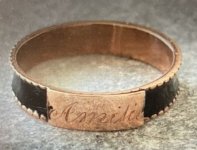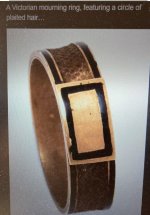lenmac65
Silver Member
- Jul 28, 2009
- 2,766
- 8,857
- 🥇 Banner finds
- 3
- Detector(s) used
- Garrett AT Pro, Equinox 800 (as of 10/2019)
- Primary Interest:
- Metal Detecting
Hello. I posted this ring on the Today’s Finds forum the other day. I believe it is copper with gold gilding. Have any of you seen a ring like this or have a guess as to its age? I found it near a cellar hole dating from at least the 1850s. The relics and coins I found nearby were all from the early to mid-1800s, so I’m guessing that is the approximate time frame for this ring. However, a knowledgeable person suggested it might be later than that, so I don’t know. Also, does anyone think this might be a mourning ring? I think the rectangular box is curious, and the black marks that I circled in blue could be adhesive, I suppose. However, I know little about jewelry or how it is fabricated, so I may be way off with this idea. I did include pictures of a couple mourning rings, as I do see some similarities. Anyway, if anyone has some insights about this ring or its age, I would be grateful. Thank you.
















